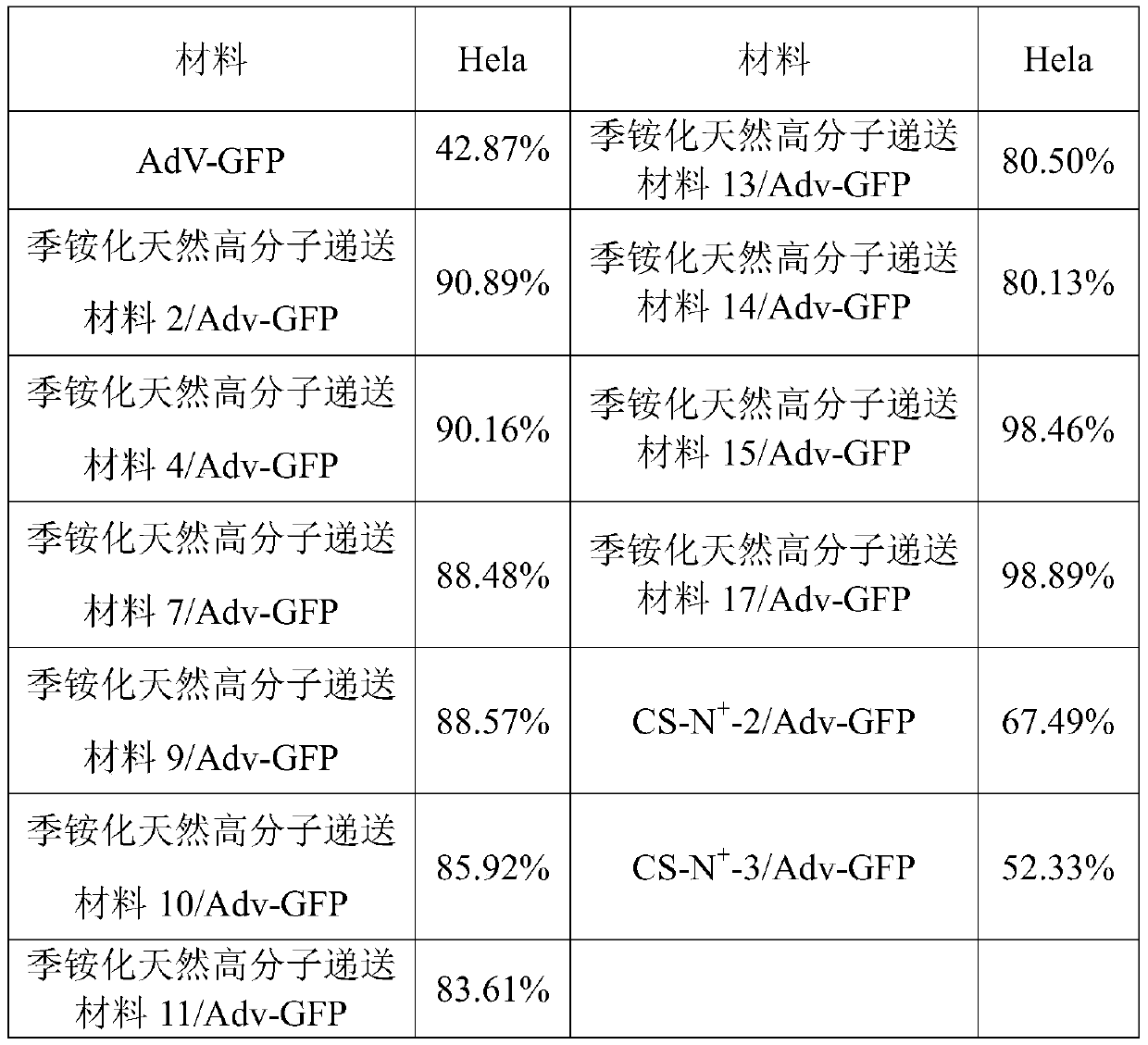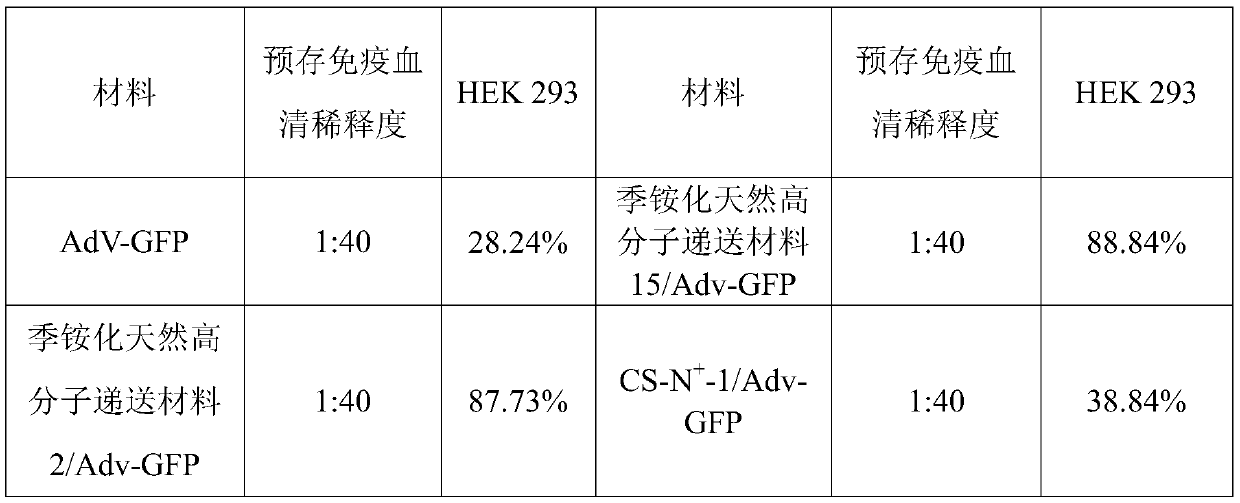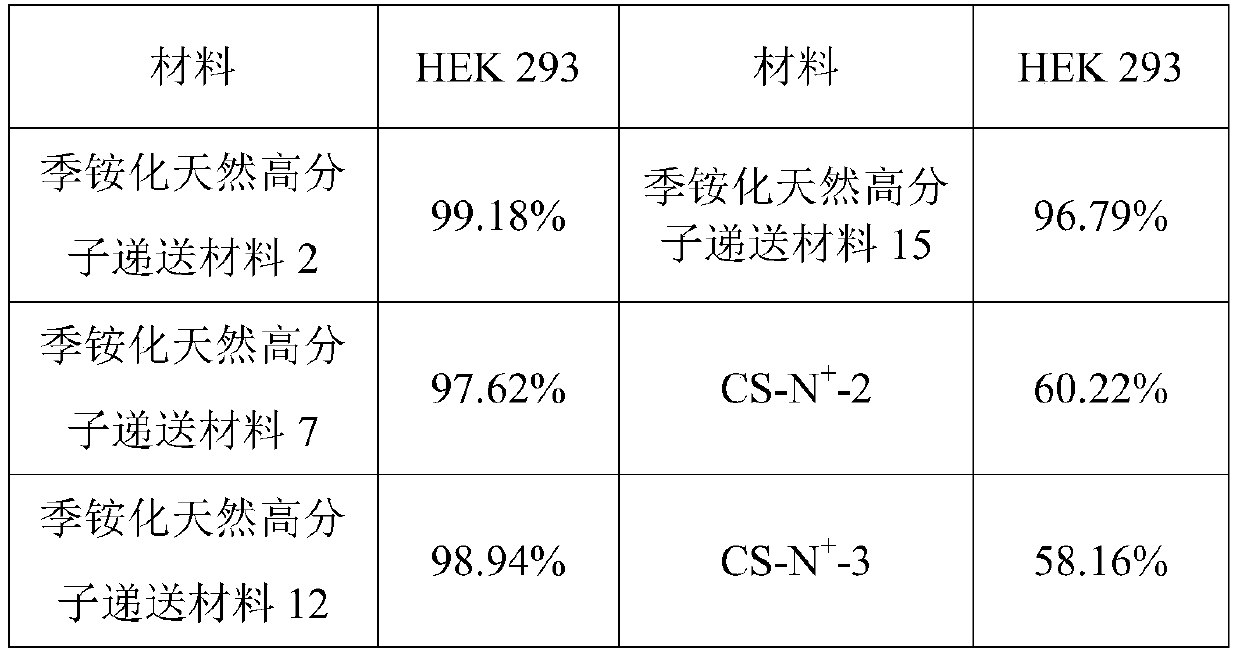Application of quaternized natural polymer material as virus vector delivery enhancing material
A technology of natural polymers and viral vectors, which is applied in the application field of quaternized natural polymer materials as viral vector delivery enhancement materials, and can solve the problem of difficult balance between high nucleic acid delivery efficiency and high biocompatibility of viral vectors. Normalize the problems of delivery efficiency and poor biocompatibility, and achieve the effect of improving nucleic acid delivery efficiency and biocompatibility, improving nucleic acid delivery efficiency, and improving delivery efficiency
- Summary
- Abstract
- Description
- Claims
- Application Information
AI Technical Summary
Problems solved by technology
Method used
Image
Examples
Embodiment 1
[0020] 1) Add 2.0g of epichlorohydrin dropwise to 3.0g of N,N-dimethylethylamine, stir at 50°C for 8 hours, after the end, precipitate and wash with diethyl ether and n-hexane twice, and dry under reduced pressure to obtain cyclo Oxygen quaternary ammonium salt A, molecular formula is
[0021] 2) Add 2.0 g of chitosan citrate (degree of deacetylation: 95%, average molecular weight: 6000) into 200 mL of deionized water, and heat to dissolve at 50° C. Afterwards, 2.5 g of epoxy quaternary ammonium salt A was dissolved in 20 mL of deionized water and added to the chitosan citrate solution, and reacted at 50° C. for 48 hours.
[0022] 3) After the reaction, wash with ethanol precipitation for 3 times, and dry under reduced pressure to obtain the quaternized natural polymer delivery material 1.
Embodiment 2
[0024] 1) Add 10g of epichlorohydrin dropwise to 30g of N,N-dimethylpropylamine, stir at 35°C for 24 hours, after the end, precipitate and wash with petroleum ether and n-hexane for 3 times, dry under reduced pressure to obtain epoxy quaternary ammonium salt B, the molecular formula is
[0025] 2) Add 3.0 g of chitosan hydrochloride (degree of deacetylation: 90%, average molecular weight: 20000) into 200 mL of deionized water, and heat to dissolve at 45° C. Then 1.0 g of epoxy quaternary ammonium salt B was dissolved in 10 mL of deionized water and added to the chitosan hydrochloride solution, and reacted at 40° C. for 24 hours.
[0026] 3) After the reaction, wash twice with ethanol precipitation, dialyze and freeze-dry to obtain the quaternized natural polymer delivery material 2.
Embodiment 3
[0028] 1) Dissolve 5.0g of hydroxypropyl cellulose (average molecular weight: 18000) in 40mL of N,N-dimethylformamide, add 1.5g of phenyl p-nitrochloroformate and 10mL of pyridine, and stir at 0°C for 4 hours. It was then precipitated 3 times with anhydrous ether.
[0029] 2) Add the product purified in step 1) into 30 mL of N,N-dimethylformamide, add 4.5 g of ethylenediamine, and stir for 24 hours at 25°C under a nitrogen atmosphere.
[0030] 3) Precipitate in ether for 3 times, and dry in vacuum to obtain hydroxypropyl cellulose with primary amino groups.
[0031] 4) Dissolve 2.0g aminohydroxypropyl cellulose in 200mL deionized water; add 0.4g 3-chloro-2-hydroxypropyltrimethylammonium chloride and 0.4g sodium hydroxide in 20mL deionized water, React at 30°C for 24 hours.
[0032] 5) After the reaction, wash with ethanol precipitation for 3 times, and dry under reduced pressure to obtain the quaternized natural polymer delivery material 3.
PUM
 Login to View More
Login to View More Abstract
Description
Claims
Application Information
 Login to View More
Login to View More - R&D
- Intellectual Property
- Life Sciences
- Materials
- Tech Scout
- Unparalleled Data Quality
- Higher Quality Content
- 60% Fewer Hallucinations
Browse by: Latest US Patents, China's latest patents, Technical Efficacy Thesaurus, Application Domain, Technology Topic, Popular Technical Reports.
© 2025 PatSnap. All rights reserved.Legal|Privacy policy|Modern Slavery Act Transparency Statement|Sitemap|About US| Contact US: help@patsnap.com



